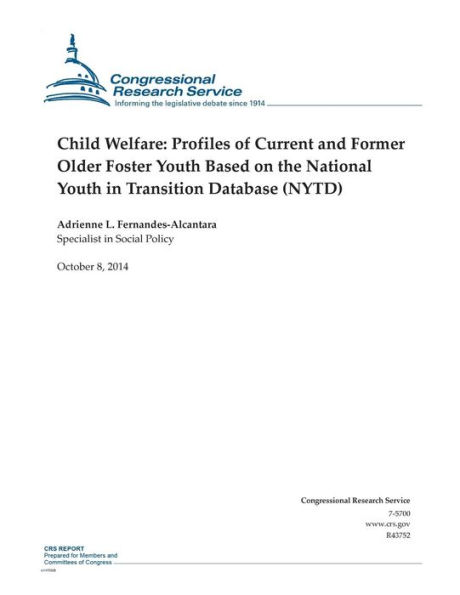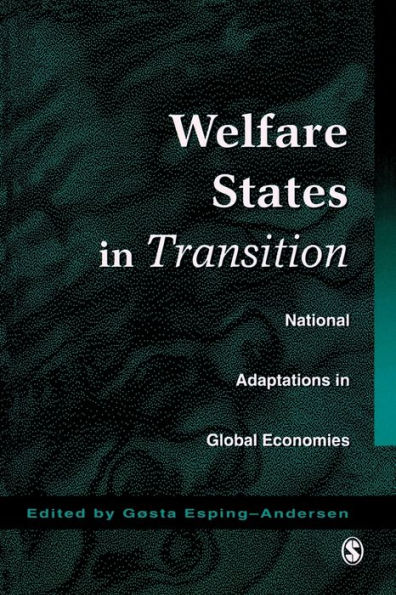Home
Child Welfare: Profiles of Current and Former Older Foster Youth Based on the National Youth in Transition Database (NYTD)
Barnes and Noble
Child Welfare: Profiles of Current and Former Older Foster Youth Based on the National Youth in Transition Database (NYTD)
Current price: $19.95


Barnes and Noble
Child Welfare: Profiles of Current and Former Older Foster Youth Based on the National Youth in Transition Database (NYTD)
Current price: $19.95
Size: OS
Loading Inventory...
*Product information may vary - to confirm product availability, pricing, shipping and return information please contact Barnes and Noble
Congress has long been concerned with the well-being of older youth in foster care and those who have recently emancipated from care without going to a permanent home. Research on this population is fairly limited, and the few studies that are available have focused on youth who live in a small number of states. This research has generally found that youth who spend time in foster care during their teenage years tend to have difficulty as they enter adulthood and beyond. The Chafee Foster Care Independence Act (P.L. 106-169), enacted in 1999, specified that state child welfare agencies provide additional supports to youth transitioning from foster care under the newly created Chafee Foster Care Independence Program (CFCIP). The law also directed the U.S. Department of Health and Human Services (HHS), which administers child welfare programs, to consult with stakeholders to develop a national data system on the number, characteristics, and outcomes of current and former foster youth. In response to these requirements, HHS created the National Youth in Transition Database (NYTD) under a final rule promulgated in 2008. The rule requires that each state child welfare agency commence collecting and reporting the data beginning in FY2011 (October 1, 2010). This report provides summary and detailed data about current and former foster youth, as reported by states to HHS via the National Youth in Transition Database (NYTD). Data are available on two sets of youth. First, states report information each fiscal year on eligible youth who currently receive independent living services regardless of whether they continue to remain in foster care, were in foster care in another state, or received child welfare services through an Indian tribe or privately operated foster care program. These youth are known as served youth. Data on served youth are intended to show how many youth received independent living services. Second, states report information on foster youth on or about their 17th birthday, on or about their 19th birthday, and on or about their 21st birthday. This reported information is based primarily on data collected through surveys of the youth. In this second group, foster youth at age 17 are known as the baseline youth, and at ages 19 and 21 they are known as the follow-up youth. Data from the tracked population of youth are intended to show education, work, health, and other outcomes of youth who were in foster care at age 17. These current and former foster youth are tracked regardless of whether they receive independent living services at ages 17, 19, and 21. As noted, states began reporting NYTD data to HHS for served and baseline youth in FY2011. The data in this report include those for served youth in FY2011 through FY2013 and for follow-up youth for FY2013. Between 97,000 and 102,000 youth received an independent living service in each of FY2011 through FY2013. The median age of these youth was 18. In each of the three years, the most common independent living services they received were academic support, career preparation, and education about housing and home management. Approximately 7,500 follow-up youth were surveyed about their outcomes at age 19. About one-third of youth were working full-time and/or part-time. Just over half (54%) were enrolled in school. Almost all of the youth had a positive connection with an adult who could serve in a mentoring or substitute parent role. Most youth had not experienced homelessness or incarceration in their lifetimes. The majority of youth had Medicaid or some other health insurance. However, youth who were no longer in foster care tended to have more negative outcomes on certain indicators. For example, youth in foster care were much less likely to report ever having been homeless compared to youth who left care (11% versus 24%). Likewise, they were less likely to report having ever been incarcerated compared to these same peers (14% versus 29%).








